Background:
I've been dabbling in photography since I was a little kid. I got my first DSLR when I went to college, a 20D, and I used it for years. It was a hand-me down from my dad and sister who are extreme hobbyist and professional, respectively. Mostly I thought, hey, sweet camera, sweet pictures. I was disappointed. It took me about 10 years of casual use to really figure out how to use it. I learned the basics, but I never really understood everything or how to apply it to make my photography better. Occasionally I got lucky, which kept me coming back. Fast forward to last November, my wife and I had a 4 month old kid at home and were financially stable enough to afford a replacement to my cam, or at the time, I thought something to make my photography better. Well, the old 20D was a bit long in the tooth and it was time for an upgrade, but I was surprised when I got my new 70D that it didn't magically improve the quality of my shots (sound familiar? The typical non-photographer consumer mentality here).
However, despite this, my money still means a lot to me, and you bet I did a ton of research on it before I pulled the trigger. I was also excited to have a new piece of equipment, which meant I used it a lot more, and we had a few big family/fun trips to help me find creative things to take pics of. Suffice it to say, I have learned more in the last 5 months of shooting than I have in the last 10 years of my DSLR experience. It's been awesome. I am now much more confident with the camera, and it's way more enjoyable now. Just learning about light, fully understanding the exposure triangle, and the nuances of each of my lenses has drastically improved my photography (IMHO, of course - you guys can be the judge of that in the "A Picture I Took" thread).
But I still wasn't completely happy with my new camera. My biggest gripe with my old one was that I could never be sure I could get a good shot - either things were blurry and unsusable, or really grainy. Well, my 70D has produced a ton of grain, even in fairly well-lit environments. Because of this I've been getting a lot better at sharpening my images, using masking and noise reduction to help. But it got me thinking. My 70D has the same sensor size as my old 20D, but with way more pixels per image. Could this be affecting the noise of the images coming out of my new camera?
I recently ran out of pictures to edit, and being too lazy to go take more, I decided to go back to some of my old pictures and play around with them. To my surprise, a lot of my old pictures from my 20D were turning out great! They had pretty low noise and lots of detail. See the post here for some examples. So then this got me really thinking...
Question:
Does the sensor resolution (megapixels) affect noise output? I've heard that bigger sensors are better for noise. Each sensor well is larger so it is collecting more light, and the construction of the sensor is such that electron pathways are not as close together and thus there is less interference between each pixel and less noise in the output image. The same thing happens when you take the same size sensor (1.6x crop factor APS-C in my case) and cram in more sensor wells for a higher resolution image (i.e. more megapixels). Each sensor well gets smaller (collecting less light per pixel), the manufacturing process gets smaller, there is more electronic interference, and images get more grainy. My 20D has an 8MP sensor. My 70D has a 20MP sensor. They are both the same size.
Now, granted, the 70D was released in 2013, and the 20D was released in 2004, almost 10 years apart. This is a geologic era difference in the technology world, so perhaps there have been other improvements to the sensors over time that would negate this effect. My goal is to figure out which one of these two cameras has more noise, and possibly explain why. So, I decided to make the following simple experiment.
Methodology and setup considerations:
Since we're just testing noise and ISO performance, I went out during a time with a little lower available light (sunset) to make sure I could compensate with enough available shutter speeds to shoot at all available ISO's, and tried to keep everything else constant.
I picked my best lens, a Canon EF 70-200 f/2.8 IS USM to get the clearest shots. I tried to stay away from the extreme ends of the lens, shooting at 75mm. I guess I could have picked 100-150mm, but this lens is really pretty good all throughout and 75mm gave me a decent composition for an already pretty boring shot. I used an aperture of f/8.0 to avoid low f-stop blurriness and high f-stop diffraction. Image stabilization was turned off, and the lens was set to manual focus. I tried to focus on the corner of the roof just under the satellite dish
I used a tripod, but I realized with the weight of this lens and my camera body that it's not the best tripod - the legs would resonate a bit if I bumped it, and the joints flexed a bit. I also forgot to use a delayed shutter release, so a couple of the images got a bit less sharp due to some vibrations, unfortunately.
Both cameras were set to aperture priority. I picked f/8 to hold it there and allowed the camera to choose an appropriate shutter speed to get a good exposure with the given ISO. I started at the lowest ISO on the 70D (100), increased by a full stop for each picture up to the maximum of the camera (25,600), then swapped bodies and did the same for the 20D (100-3,200).
I tried my best to remove any in-camera processing and any post-processing by lightroom. No exposure compensations, light adjustments, and most importantly no sharpening or noise reduction.
This was my test setting and composition:
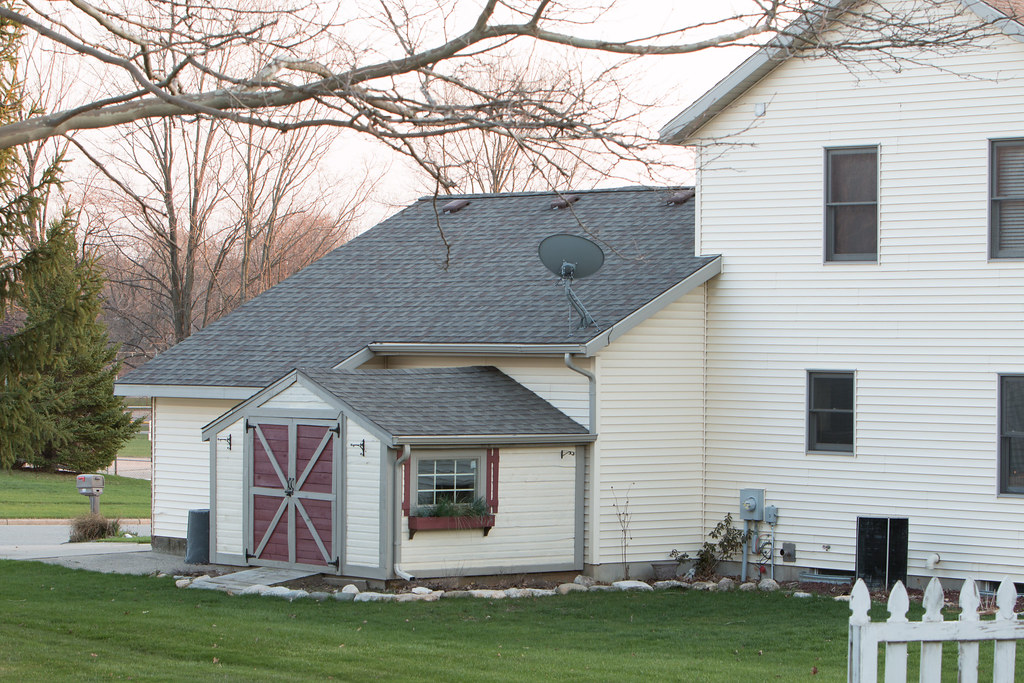 70D-100 by jamsomito, on Flickr
70D-100 by jamsomito, on Flickr
I didn't get too crazy with the location. This is just looking out my back door at the neighbor's house (outside of course, not through the glass). I wanted something that would give a bit of detail, but also have some flat surfaces to see how the noise would fare on flat vs detailed areas.
After I took the pictures, I imported them into lightroom, exported as jpg's with 100% quality (minimal compression). Then I went and made a crop to see what the grain would look like blown up a bit. I tried to pick an area towards the middle to avoid any edge distortion/vignetting/blurriness from the lens, but also provide detail in the shingles and tree branches, flatness in the siding/sky, brightness of the sky, and some shadows. It turns out the back of the satellite dish is the best example of a "flat" spot on the image.
Results:
20D - 100 ISO (cropped)
20D - 200 ISO (cropped)
20D - 400 ISO (cropped)
20D - 800 ISO (cropped)
20D - 1600 ISO (cropped)
20D - 3200 ISO (cropped)
70D - 100 ISO (cropped)
70D - 200 ISO (cropped)
70D - 400 ISO (cropped)
70D - 800 ISO (cropped)
70D - 1600 ISO (cropped)
70D - 3200 ISO (cropped)
70D - 6400 ISO (cropped)
70D - 12800 ISO (cropped)
70D - 25600 ISO (cropped)
Comparisons:
At 100 ISO, while you can barely pick out some, the noise is more ore less negligible on both the 20D and the 70D. It's perhaps slightly more pronounced on the 20D.
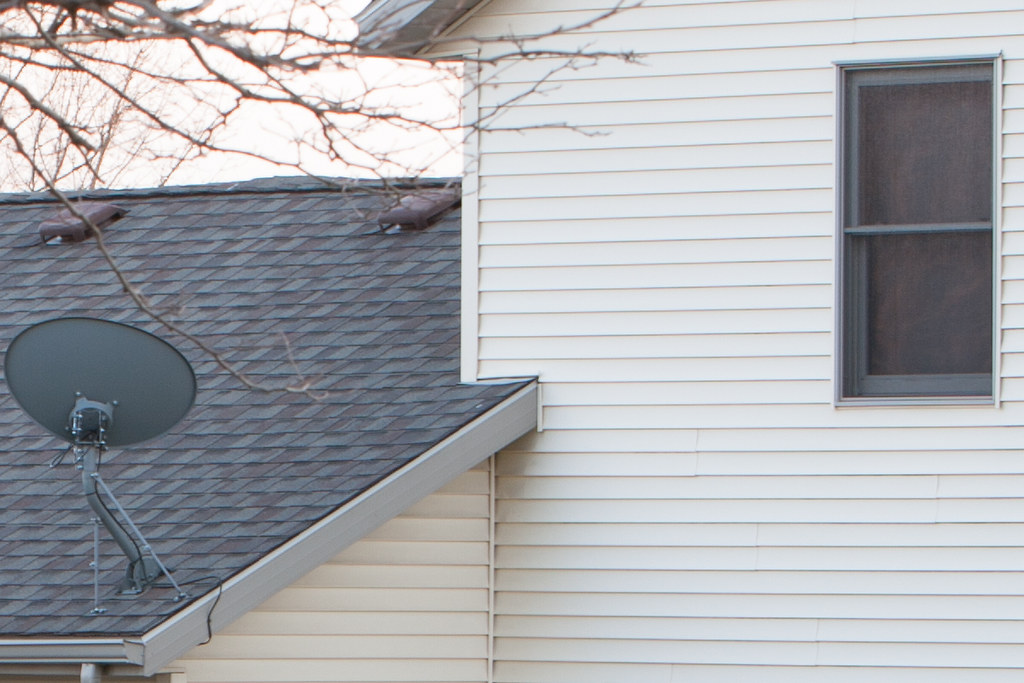 20D-100 crop by jamsomito, on Flickr
20D-100 crop by jamsomito, on Flickr
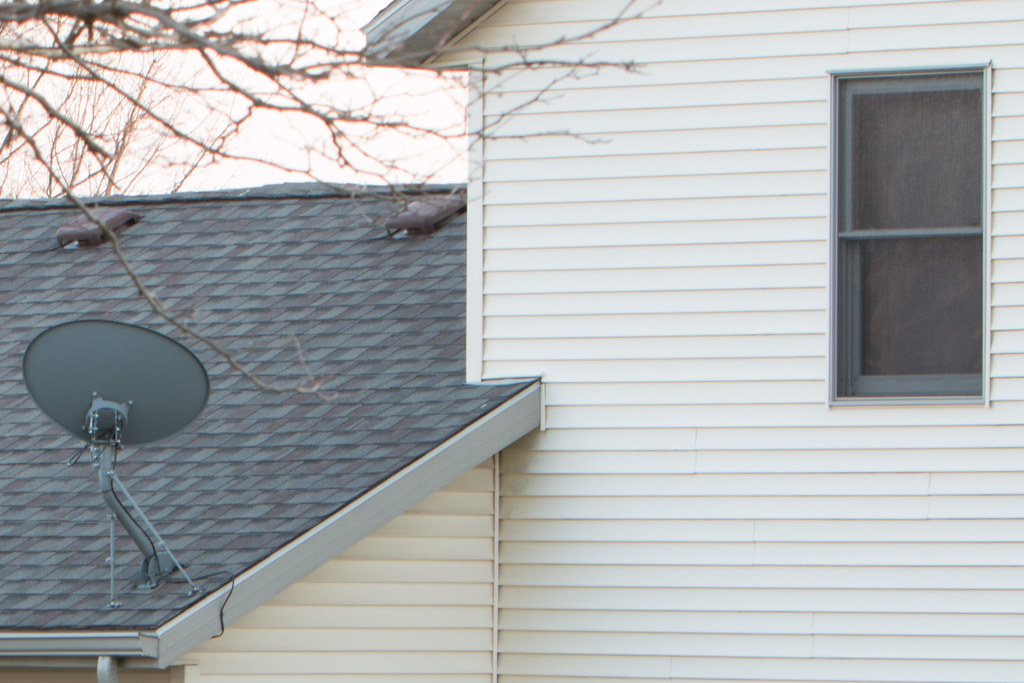 70D-100 crop by jamsomito, on Flickr
70D-100 crop by jamsomito, on Flickr
At 400 ISO, noise is just starting to creep into the 70D shot, and is definitely noticeable on the 20D.
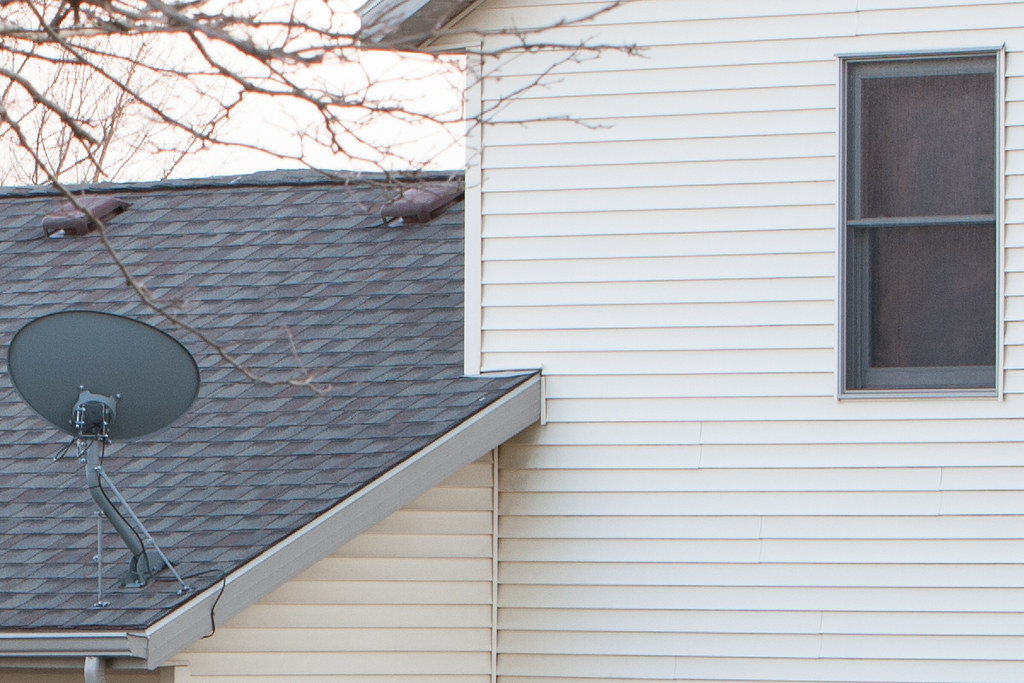 20D-400 crop by jamsomito, on Flickr
20D-400 crop by jamsomito, on Flickr
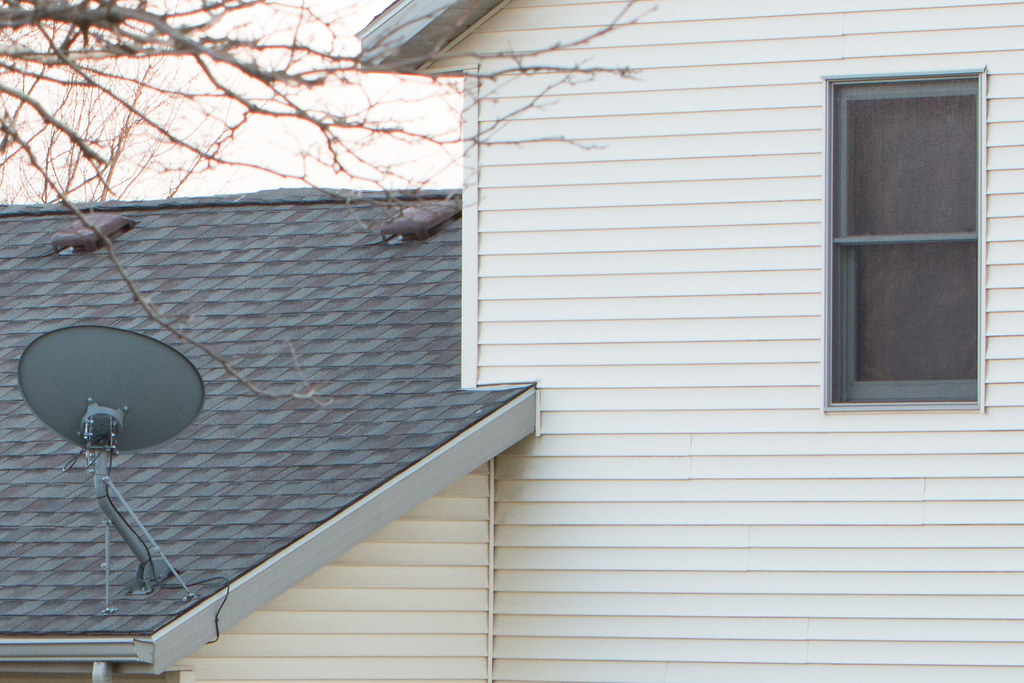 70D-400 crop by jamsomito, on Flickr
70D-400 crop by jamsomito, on Flickr
At 1600 ISO, the highest the 20D will go without expansion, the 70D wins by quite a bit. The 20D shows noticeably blocky grain throughout the image - flat surfaces and detailed surfaces alike, and is even starting to show on lighter areas like the siding of the house. The 70D, while showing grain on both flat and detailed surfaces, is much finer. There is also not as much detail lost through the screen on the window - the 20D is clearly showing some distortion where the grain appears to form some unsightly lines.
 20D-1600 crop by jamsomito, on Flickr
20D-1600 crop by jamsomito, on Flickr
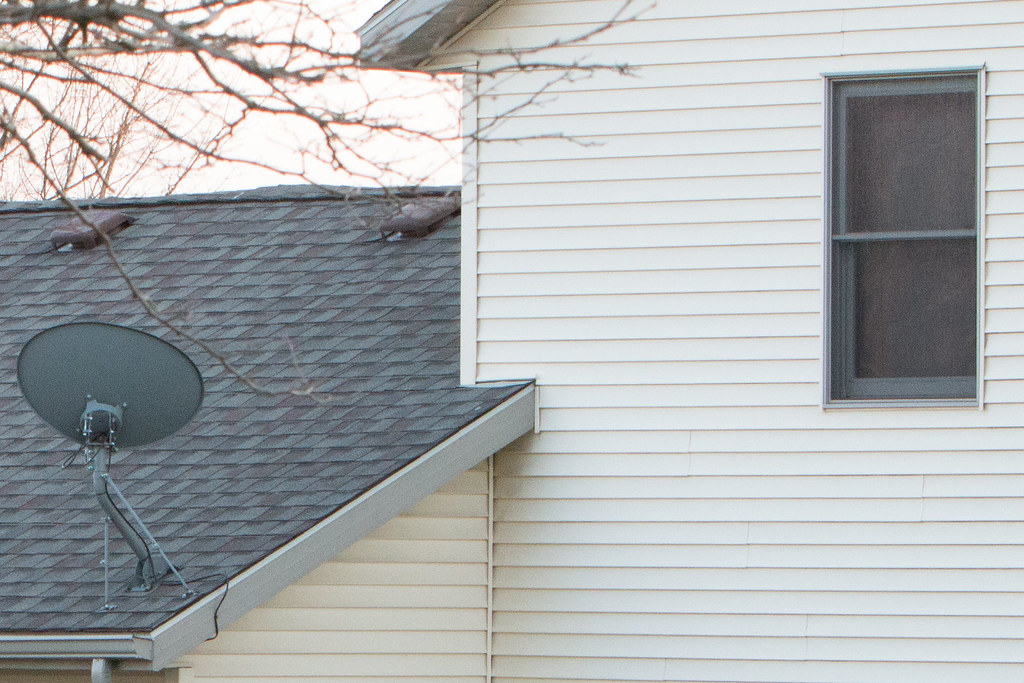 70D-1600 crop by jamsomito, on Flickr
70D-1600 crop by jamsomito, on Flickr
There is no comparison at higher ISO's because of the 20D's limitation of 1600 ISO (except for maybe the expanded mode), so here is the 70D at 3200 ISO and 6400 ISO in comparison to the 20D at 1600 ISO. They are actually starting to look very similar. To me, it appears that the 70D at 3200 has similar, but still better grain than the 20D at 1600, but the grain finally gets worse than the 20D @ 1600 when the 70D is set at 6400 and beyond.
 20D-1600 crop by jamsomito, on Flickr
20D-1600 crop by jamsomito, on Flickr
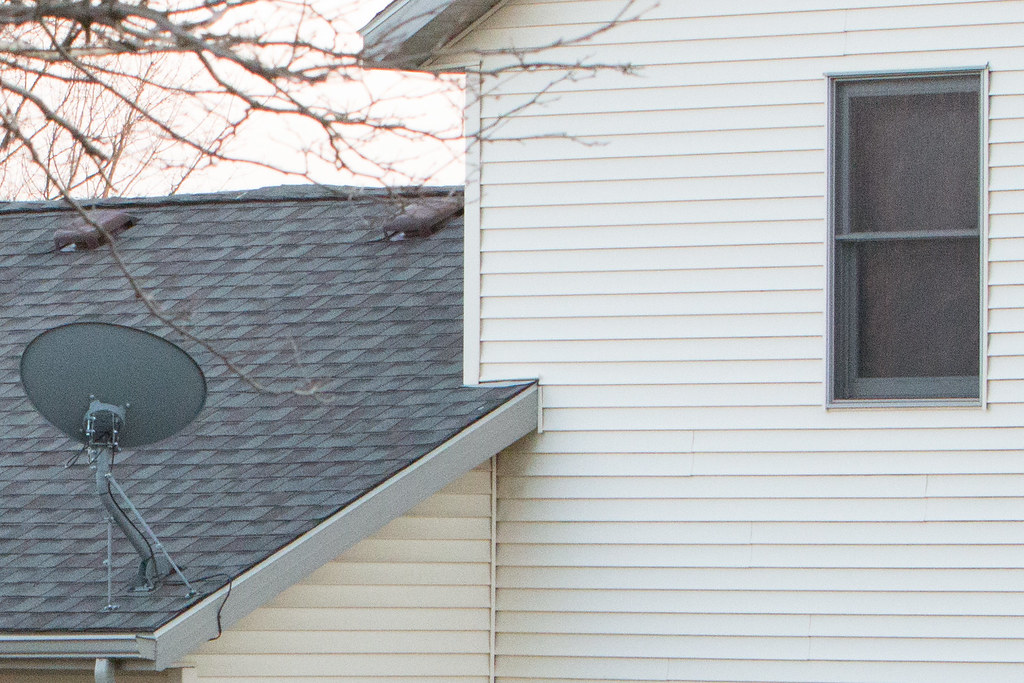 70D-3200 crop by jamsomito, on Flickr
70D-3200 crop by jamsomito, on Flickr
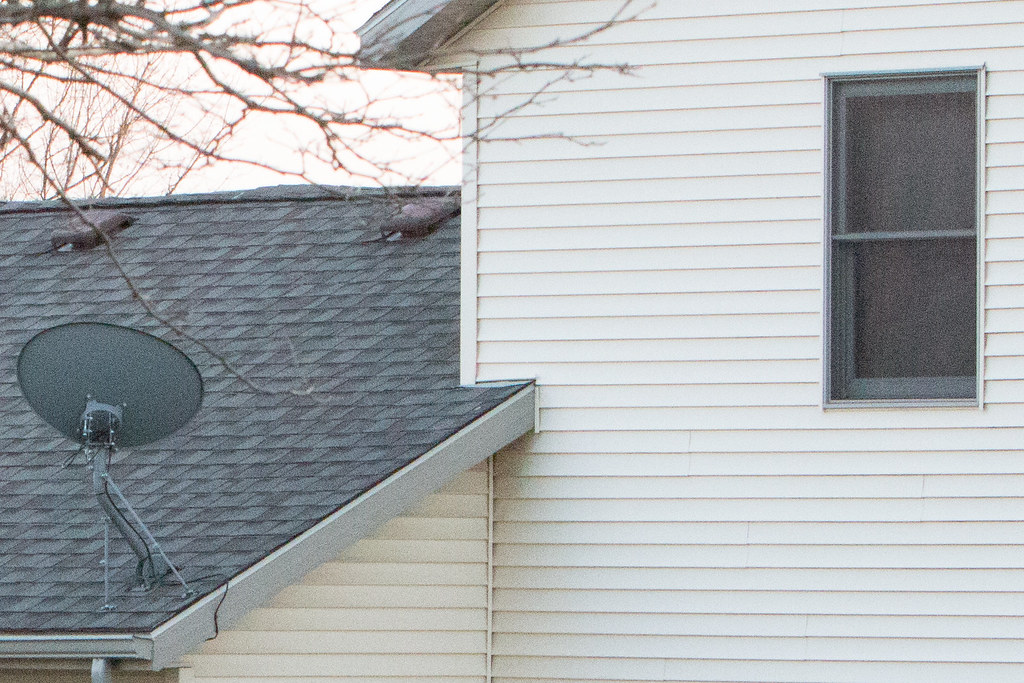 70D-6400 crop by jamsomito, on Flickr
70D-6400 crop by jamsomito, on Flickr
And just for fun, here is the expanded mode on the 20D (3200 ISO) vs expanded on 70D (25600 ISO). They're both awful, though surprisingly the 20D's is much more usable. The 70D shows significantly more grain, almost like the house is made of sand, and also more color distortion as well. The 70D also shows more grain distortion in a "grouping" effect as can be seen in the lines on the window screen.
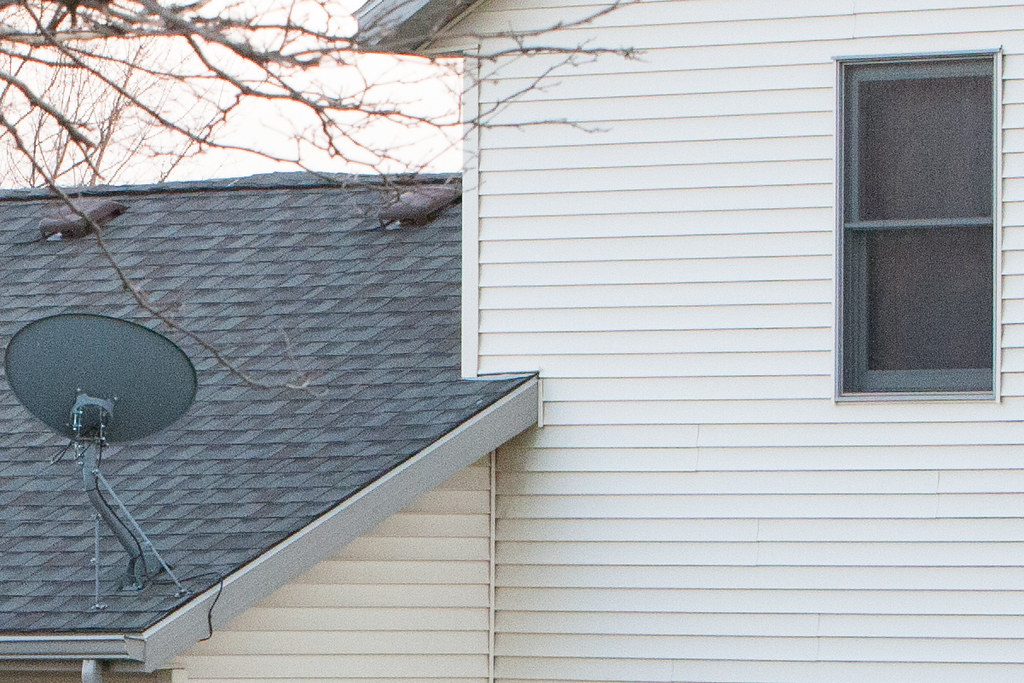 20D-3200 crop by jamsomito, on Flickr
20D-3200 crop by jamsomito, on Flickr
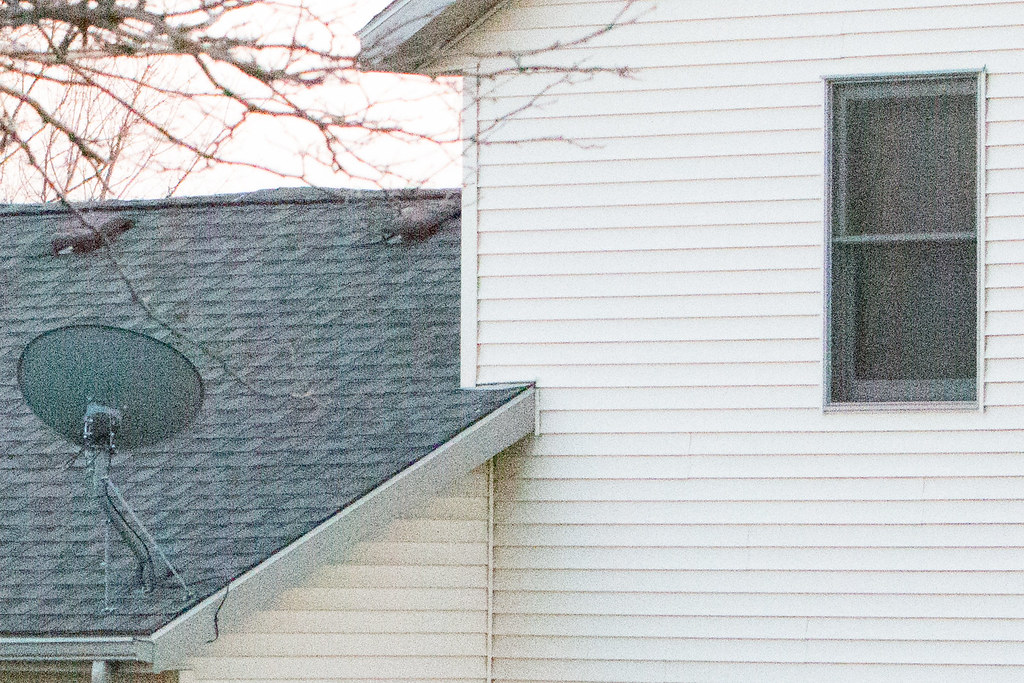 70D-25600 crop by jamsomito, on Flickr
70D-25600 crop by jamsomito, on Flickr
Observations:
At ISO 100, the 20D and the 70D both are really pretty good - the 70D being slightly better - but both have ever so slightly noticeable grain. At higher ISO's (400 and beyond) the 70D looks like it provides about a stop to a stop-and-a-half of improved grain. The expanded ISO 3200 on the 20D is actually usable, being similar to the 70D's performance somewhere between ISO 6400 and 12800. However, the 70D's expanded 25600 ISO is a joke and clearly a marketing gimmick. I would hate to see what it's like with longer exposures in even less light. I suppose it's there "if you need it" like everyone says, but think about this. If you're ever deep in the woods and you spot big-foot, crank the ISO to make sure you just get a picture of him, are you really helping the situation? I mean most of the pictures of big-foot are terrible, and that's why there's so much controversy over his existence. Adding another crappy picture where you can't tell big-foot's leg from a tree stump because there's so much grain and distortion in the image is only going to exacerbate the problem.
Looking at other things, colors seem pretty close to me, but maybe a bit more realistic in the greens on the 70D. Resolution is far better on the 70D. 8MP is just not enough for today's standards. The 20D does produce some jagged edges due to lack of resolution (take a look at the branches in the distance above the roof line).
Conclusion:
In the case of comparison of noise performance between the 20D and 70D, the 70D is the clear winner. Not only does it perform better at any given ISO (about a stop and a half with respect to noise levels), there are other notable improvements that were not tested here such as auto focus speed, video capabilities, much higher resolution, better dynamic range, better color reproduction, etc, etc. 8MP is not enough for today's standards. However, it appears as if sensor technology has advanced enough in the last 10 years to keep noise levels low despite drastic jumps in resolution (megapixels). They actually improved it to surpass the noise performance of the sensors of old and improve on them.
This does raise the question about the same sensor built with today's technology with different resolutions and how it would affect noise levels, but one thing is for sure, today's sensors are better than before and are indeed improving with each generation. I'm glad I ran through this effort to convince myself that the new 70D is better than my now antiquated 20D, but, the 20D was not as bad as I originally thought. It gave a valiant effort that shows equipment can only do so much to improve your photography - the majority of the improvement will come from learning how to use the equipment you've got, both cameras and lenses, as well as editing software.
So to you veterans, yes the 70D is better than the 20D. And to you newbies, learn how to use the one you've got! The best camera is the one you've got on you (if you know how to use it).
Please do feel free to leave feedback of any kind. I hope this is helpful for some and might raise some good discussions about sensor resolution and noise performance.
I've been dabbling in photography since I was a little kid. I got my first DSLR when I went to college, a 20D, and I used it for years. It was a hand-me down from my dad and sister who are extreme hobbyist and professional, respectively. Mostly I thought, hey, sweet camera, sweet pictures. I was disappointed. It took me about 10 years of casual use to really figure out how to use it. I learned the basics, but I never really understood everything or how to apply it to make my photography better. Occasionally I got lucky, which kept me coming back. Fast forward to last November, my wife and I had a 4 month old kid at home and were financially stable enough to afford a replacement to my cam, or at the time, I thought something to make my photography better. Well, the old 20D was a bit long in the tooth and it was time for an upgrade, but I was surprised when I got my new 70D that it didn't magically improve the quality of my shots (sound familiar? The typical non-photographer consumer mentality here).
However, despite this, my money still means a lot to me, and you bet I did a ton of research on it before I pulled the trigger. I was also excited to have a new piece of equipment, which meant I used it a lot more, and we had a few big family/fun trips to help me find creative things to take pics of. Suffice it to say, I have learned more in the last 5 months of shooting than I have in the last 10 years of my DSLR experience. It's been awesome. I am now much more confident with the camera, and it's way more enjoyable now. Just learning about light, fully understanding the exposure triangle, and the nuances of each of my lenses has drastically improved my photography (IMHO, of course - you guys can be the judge of that in the "A Picture I Took" thread).
But I still wasn't completely happy with my new camera. My biggest gripe with my old one was that I could never be sure I could get a good shot - either things were blurry and unsusable, or really grainy. Well, my 70D has produced a ton of grain, even in fairly well-lit environments. Because of this I've been getting a lot better at sharpening my images, using masking and noise reduction to help. But it got me thinking. My 70D has the same sensor size as my old 20D, but with way more pixels per image. Could this be affecting the noise of the images coming out of my new camera?
I recently ran out of pictures to edit, and being too lazy to go take more, I decided to go back to some of my old pictures and play around with them. To my surprise, a lot of my old pictures from my 20D were turning out great! They had pretty low noise and lots of detail. See the post here for some examples. So then this got me really thinking...
Question:
Does the sensor resolution (megapixels) affect noise output? I've heard that bigger sensors are better for noise. Each sensor well is larger so it is collecting more light, and the construction of the sensor is such that electron pathways are not as close together and thus there is less interference between each pixel and less noise in the output image. The same thing happens when you take the same size sensor (1.6x crop factor APS-C in my case) and cram in more sensor wells for a higher resolution image (i.e. more megapixels). Each sensor well gets smaller (collecting less light per pixel), the manufacturing process gets smaller, there is more electronic interference, and images get more grainy. My 20D has an 8MP sensor. My 70D has a 20MP sensor. They are both the same size.
Now, granted, the 70D was released in 2013, and the 20D was released in 2004, almost 10 years apart. This is a geologic era difference in the technology world, so perhaps there have been other improvements to the sensors over time that would negate this effect. My goal is to figure out which one of these two cameras has more noise, and possibly explain why. So, I decided to make the following simple experiment.
Methodology and setup considerations:
Since we're just testing noise and ISO performance, I went out during a time with a little lower available light (sunset) to make sure I could compensate with enough available shutter speeds to shoot at all available ISO's, and tried to keep everything else constant.
I picked my best lens, a Canon EF 70-200 f/2.8 IS USM to get the clearest shots. I tried to stay away from the extreme ends of the lens, shooting at 75mm. I guess I could have picked 100-150mm, but this lens is really pretty good all throughout and 75mm gave me a decent composition for an already pretty boring shot. I used an aperture of f/8.0 to avoid low f-stop blurriness and high f-stop diffraction. Image stabilization was turned off, and the lens was set to manual focus. I tried to focus on the corner of the roof just under the satellite dish
I used a tripod, but I realized with the weight of this lens and my camera body that it's not the best tripod - the legs would resonate a bit if I bumped it, and the joints flexed a bit. I also forgot to use a delayed shutter release, so a couple of the images got a bit less sharp due to some vibrations, unfortunately.
Both cameras were set to aperture priority. I picked f/8 to hold it there and allowed the camera to choose an appropriate shutter speed to get a good exposure with the given ISO. I started at the lowest ISO on the 70D (100), increased by a full stop for each picture up to the maximum of the camera (25,600), then swapped bodies and did the same for the 20D (100-3,200).
I tried my best to remove any in-camera processing and any post-processing by lightroom. No exposure compensations, light adjustments, and most importantly no sharpening or noise reduction.
This was my test setting and composition:
 70D-100 by jamsomito, on Flickr
70D-100 by jamsomito, on FlickrI didn't get too crazy with the location. This is just looking out my back door at the neighbor's house (outside of course, not through the glass). I wanted something that would give a bit of detail, but also have some flat surfaces to see how the noise would fare on flat vs detailed areas.
After I took the pictures, I imported them into lightroom, exported as jpg's with 100% quality (minimal compression). Then I went and made a crop to see what the grain would look like blown up a bit. I tried to pick an area towards the middle to avoid any edge distortion/vignetting/blurriness from the lens, but also provide detail in the shingles and tree branches, flatness in the siding/sky, brightness of the sky, and some shadows. It turns out the back of the satellite dish is the best example of a "flat" spot on the image.
Results:
20D - 100 ISO (cropped)
20D - 200 ISO (cropped)
20D - 400 ISO (cropped)
20D - 800 ISO (cropped)
20D - 1600 ISO (cropped)
20D - 3200 ISO (cropped)
70D - 100 ISO (cropped)
70D - 200 ISO (cropped)
70D - 400 ISO (cropped)
70D - 800 ISO (cropped)
70D - 1600 ISO (cropped)
70D - 3200 ISO (cropped)
70D - 6400 ISO (cropped)
70D - 12800 ISO (cropped)
70D - 25600 ISO (cropped)
Comparisons:
At 100 ISO, while you can barely pick out some, the noise is more ore less negligible on both the 20D and the 70D. It's perhaps slightly more pronounced on the 20D.
 20D-100 crop by jamsomito, on Flickr
20D-100 crop by jamsomito, on Flickr 70D-100 crop by jamsomito, on Flickr
70D-100 crop by jamsomito, on FlickrAt 400 ISO, noise is just starting to creep into the 70D shot, and is definitely noticeable on the 20D.
 20D-400 crop by jamsomito, on Flickr
20D-400 crop by jamsomito, on Flickr 70D-400 crop by jamsomito, on Flickr
70D-400 crop by jamsomito, on FlickrAt 1600 ISO, the highest the 20D will go without expansion, the 70D wins by quite a bit. The 20D shows noticeably blocky grain throughout the image - flat surfaces and detailed surfaces alike, and is even starting to show on lighter areas like the siding of the house. The 70D, while showing grain on both flat and detailed surfaces, is much finer. There is also not as much detail lost through the screen on the window - the 20D is clearly showing some distortion where the grain appears to form some unsightly lines.
 20D-1600 crop by jamsomito, on Flickr
20D-1600 crop by jamsomito, on Flickr 70D-1600 crop by jamsomito, on Flickr
70D-1600 crop by jamsomito, on FlickrThere is no comparison at higher ISO's because of the 20D's limitation of 1600 ISO (except for maybe the expanded mode), so here is the 70D at 3200 ISO and 6400 ISO in comparison to the 20D at 1600 ISO. They are actually starting to look very similar. To me, it appears that the 70D at 3200 has similar, but still better grain than the 20D at 1600, but the grain finally gets worse than the 20D @ 1600 when the 70D is set at 6400 and beyond.
 20D-1600 crop by jamsomito, on Flickr
20D-1600 crop by jamsomito, on Flickr 70D-3200 crop by jamsomito, on Flickr
70D-3200 crop by jamsomito, on Flickr 70D-6400 crop by jamsomito, on Flickr
70D-6400 crop by jamsomito, on FlickrAnd just for fun, here is the expanded mode on the 20D (3200 ISO) vs expanded on 70D (25600 ISO). They're both awful, though surprisingly the 20D's is much more usable. The 70D shows significantly more grain, almost like the house is made of sand, and also more color distortion as well. The 70D also shows more grain distortion in a "grouping" effect as can be seen in the lines on the window screen.
 20D-3200 crop by jamsomito, on Flickr
20D-3200 crop by jamsomito, on Flickr 70D-25600 crop by jamsomito, on Flickr
70D-25600 crop by jamsomito, on FlickrObservations:
At ISO 100, the 20D and the 70D both are really pretty good - the 70D being slightly better - but both have ever so slightly noticeable grain. At higher ISO's (400 and beyond) the 70D looks like it provides about a stop to a stop-and-a-half of improved grain. The expanded ISO 3200 on the 20D is actually usable, being similar to the 70D's performance somewhere between ISO 6400 and 12800. However, the 70D's expanded 25600 ISO is a joke and clearly a marketing gimmick. I would hate to see what it's like with longer exposures in even less light. I suppose it's there "if you need it" like everyone says, but think about this. If you're ever deep in the woods and you spot big-foot, crank the ISO to make sure you just get a picture of him, are you really helping the situation? I mean most of the pictures of big-foot are terrible, and that's why there's so much controversy over his existence. Adding another crappy picture where you can't tell big-foot's leg from a tree stump because there's so much grain and distortion in the image is only going to exacerbate the problem.
Looking at other things, colors seem pretty close to me, but maybe a bit more realistic in the greens on the 70D. Resolution is far better on the 70D. 8MP is just not enough for today's standards. The 20D does produce some jagged edges due to lack of resolution (take a look at the branches in the distance above the roof line).
Conclusion:
In the case of comparison of noise performance between the 20D and 70D, the 70D is the clear winner. Not only does it perform better at any given ISO (about a stop and a half with respect to noise levels), there are other notable improvements that were not tested here such as auto focus speed, video capabilities, much higher resolution, better dynamic range, better color reproduction, etc, etc. 8MP is not enough for today's standards. However, it appears as if sensor technology has advanced enough in the last 10 years to keep noise levels low despite drastic jumps in resolution (megapixels). They actually improved it to surpass the noise performance of the sensors of old and improve on them.
This does raise the question about the same sensor built with today's technology with different resolutions and how it would affect noise levels, but one thing is for sure, today's sensors are better than before and are indeed improving with each generation. I'm glad I ran through this effort to convince myself that the new 70D is better than my now antiquated 20D, but, the 20D was not as bad as I originally thought. It gave a valiant effort that shows equipment can only do so much to improve your photography - the majority of the improvement will come from learning how to use the equipment you've got, both cameras and lenses, as well as editing software.
So to you veterans, yes the 70D is better than the 20D. And to you newbies, learn how to use the one you've got! The best camera is the one you've got on you (if you know how to use it).
Please do feel free to leave feedback of any kind. I hope this is helpful for some and might raise some good discussions about sensor resolution and noise performance.
![[H]ard|Forum](/styles/hardforum/xenforo/logo_dark.png)
